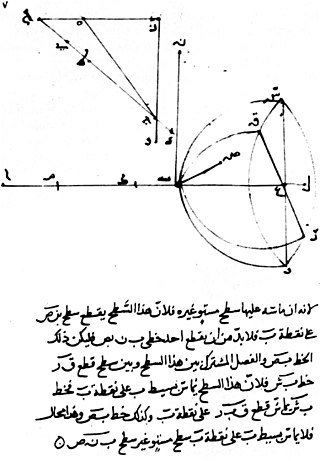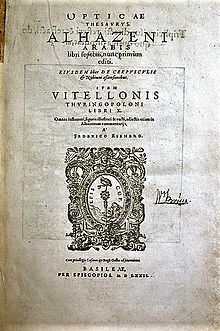
Ḥasan Ibn al-Haytham was a medieval mathematician, astronomer, and physicist of the Islamic Golden Age from present-day Iraq. Referred to as "the father of modern optics", he made significant contributions to the principles of optics and visual perception in particular. His most influential work is titled Kitāb al-Manāẓir, written during 1011–1021, which survived in a Latin edition. The works of Alhazen were frequently cited during the scientific revolution by Isaac Newton, Johannes Kepler, Christiaan Huygens, and Galileo Galilei.
The International Commission for Optics (ICO) was created in 1947 with the objective to contribute, on an international basis, to the progress and dissemination of the science of optics and photonics and their applications. It emphasises the unity of the crossdisciplinary field of optics.
SPIE is an international not-for-profit professional society for optics and photonics technology, founded in 1955. It organizes technical conferences, trade exhibitions, and continuing education programs for researchers and developers in the light-based fields of physics, including: optics, photonics, and imaging engineering. The society publishes peer-reviewed scientific journals, conference proceedings, monographs, tutorial texts, field guides, and reference volumes in print and online. SPIE is especially well-known for Photonics West, one of the laser and photonics industry's largest combined conferences and tradeshows which is held annually in San Francisco. SPIE also participates as partners in leading educational initiatives, and in 2020, for example, provided more than $5.8 million in support of optics education and outreach programs around the world.

Ibn Sahl was a Persian mathematician and physicist of the Islamic Golden Age, associated with the Buyid court of Baghdad. Nothing in his name allows us to glimpse his country of origin.
The European Optical Society (EOS), founded in 1991, is a European organisation for the development of the science of optics. Membership is open to national optical societies, individuals, companies, organisations, educational institutions, and learned and professional societies. EOS runs international conferences; lobbies for optical science at European level; offers a focus for collecting and disseminating knowledge in the field, and publishes the online journal JEOS:RP.

Nader Engheta is an Iranian-American scientist. He has made pioneering contributions to the fields of metamaterials, transformation optics, plasmonic optics, nanophotonics, graphene photonics, nano-materials, nanoscale optics, nano-antennas and miniaturized antennas, physics and reverse-engineering of polarization vision in nature, bio-inspired optical imaging, fractional paradigm in electrodynamics, and electromagnetics and microwaves.

Allan Dawson Boardman was a British physicist, known for his work on surface plasmons and guided wave optics, especially nonlinear waves, solitons, magneto-optics and negative refracting metamaterials. He was a theorist and numerical analyst in these areas, especially magneto-optics and metamaterials. In 2006 he was made a fellow of the Optical Society of America for his contributions in these fields and for "exemplary leadership and service to the optics community".

Chinese Optics Letters is a monthly peer-reviewed scientific journal published by Optica. Established in 2003, it covers optics research originating in the People's Republic of China as well as coverage from groups outside the country.

Vladimir (Vlad) M. Shalaev is a Distinguished Professor of Electrical and Computer Engineering and Scientific Director for Nanophotonics at Birck Nanotechnology Center, Purdue University.

Anthony Michael Johnson is an American experimental physicist, a professor of physics, and a professor of computer science and electrical engineering at the University of Maryland, Baltimore County (UMBC). He is the director of the Center for Advanced Studies in Photonics Research (CASPR), also situated on campus at UMBC. Since his election to the 2002 term as president of the Optical Society, formerly the Optical Society of America, Johnson has the distinction of being the first and only African-American president to date. Johnson's research interests include the ultrafast photophysics and nonlinear optical properties of bulk, nanostructured, and quantum well semiconductor structures, ultrashort pulse propagation in fibers and high-speed lightwave systems. His research has helped to better understand processes that occur in ultrafast time frames of 1 quadrillionth of a second. Ultrashort pulses of light have been used to address technical and logistical challenges in medicine, telecommunications, homeland security, and have many other applications that enhance contemporary life.
James Clair Wyant was a professor at the College of Optical Sciences at the University of Arizona where he was Director (1999–2005) and Dean (2005–2012). He received a B.S. in physics from Case Western Reserve University and M.S. and Ph.D. in optics from the Institute of Optics at the University of Rochester.
John Michael Dudley is a physicist and currently Professor of Physics at the University Bourgogne Franche-Comté working at the joint University-CNRS research Institute FEMTO-ST in Besançon, France. Originally from New Zealand, he is known for his research in nonlinear and ultrafast optical physics, for service to international scientific societies, and for initiatives in promoting international scientific outreach and the public communication of science.

Paul F. McManamon is an American scientist who is best known for his work in optics and photonics, as well as sensors, countermeasures, and directed energy.

Anurag Sharma is an Indian physicist and a professor at the department of physics of the Indian Institute of Technology Delhi. He is known for his pioneering researches on optoelectronics and optical communications and is an elected fellow of all the three major Indian science academies viz. Indian Academy of Sciences, Indian National Science Academy and National Academy of Sciences, India as well as Indian National Academy of Engineering. The Council of Scientific and Industrial Research, the apex agency of the Government of India for scientific research, awarded him the Shanti Swarup Bhatnagar Prize for Science and Technology, one of the highest Indian science awards for his contributions to Engineering Sciences in 1998.

Din Ping Tsai is a physicist known for his work in the fields of photonics. He is currently a Distinguished Professor at the National Taiwan University and Director of the Research Center for Applied Sciences, Academia Sinica. He has been President of Taiwan Information Storage Association (TISA) since 2015.

Anatoly V. Zayats is a British experimental physicist of Ukrainian origin known for his work in nanophotonics, plasmonics, metamaterials and applied nanotechnology. He is currently a Chair in Experimental Physics and the head of the Photonics & Nanotechnology Group at King's College London. He is a co-director of the London Centre for Nanotechnology and the London Institute for Advanced Light Technologies
María Josefa Yzuel Giménez is a professor of physics at the Autonomous University of Barcelona. She has worked in medical optics, diffraction image theory, image quality evaluation and liquid crystals. She served as president of SPIE in 2009.
Peter J. Delfyett Jr is an American engineer and Pegasus Professor and Trustee Chair Professor of Optics, ECE & Physics at the University of Central Florida College of Optics and Photonics.

Jürgen W. Czarske is a German electrical engineer and a measurement system technician. He is the director of the TU Dresden Biomedical Computational Laser Systems competence center and a co-opted professor of physics.
John Ballato is an American materials scientist, entrepreneur, and academic. He holds the J. E. Sirrine Endowed Chair of Optical Fiber and is a professor of materials science and engineering, electrical and computer engineering, as well as physics and astronomy at Clemson University. He has received many international recognitions for his research on optical and optoelectronic materials, particularly as relates to optical fiber.















